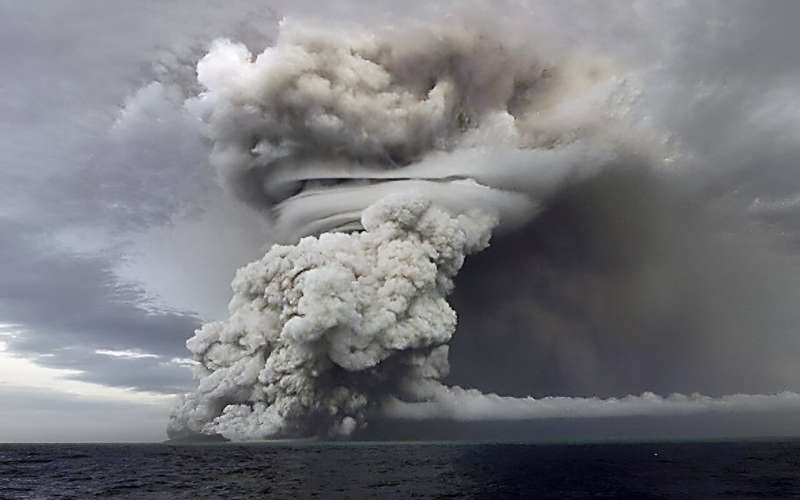
Hunga Tonga volcano, photographed during its eruption on January 14-15, 2022. Credit: Tonga Geological Services / ZUMA Press / Zuma / REA, Dr. Mark Schoeberl
New research from a collaborative team including Texas A&M University atmospheric scientist Dr. Andrew Dessler explores the climate impact of the 2022 Hunga Tonga volcano eruption and challenges existing assumptions about its effects in the process.
This remarkable two-day event, which occurred in mid-January 2022, injected large amounts of volcanic aerosols and water vapor into the atmosphere. Historically, large volcanic eruptions such as Tambora in 1815 and Mount Pinatubo in 1991 have had significant cooling effects on the global climate by blocking sunlight with their aerosols.
However, the Hunga Tonga eruption presented a unique scenario: as a submarine volcano, it introduced an unprecedented amount of water vapor into the stratosphere, increasing the total stratospheric water content by about 10%.
Because water vapor is a powerful greenhouse gas, Dessler says there was initially speculation that it could be responsible for the planet’s extreme heat in 2023 and 2024. Instead, the team’s research results, published Wednesday (July 24) in the Journal of Geophysical Research: Atmospheresreveal the opposite: the eruption actually helped cool the Earth, like other major volcanic events.
The cooling effect of a volcanic eruption
The team’s paper, “Evolution of the Climate Forcing During the Two Years After the Hunga Tonga-Hunga Ha’apai Eruption,” includes insights and analysis from Dessler, a professor in the Department of Atmospheric Sciences at Texas A&M and director of the Texas Center for Climate Studies; first author Dr. Mark Schoeberl, chief scientist at the Science and Technology Corporation, based in Hamburg, Virginia; and several scientists from the National Aeronautics and Space Administration (NASA).
Their methodology involved analyzing NASA and National Oceanic and Atmospheric Administration (NOAA) satellite observations of aerosols and water vapor, among other variables, to estimate the energy budget of Earth’s climate system. Their analysis found that the eruption caused more energy to flow out of the climate system than it did into it, resulting in a slight cooling effect.
“Our paper casts a chill on the explanation that the eruption caused the extreme heat of 2023 and 2024,” Dessler says. “Instead, we should focus on greenhouse gases from human activities as the main cause of the warming, with significant help from the ongoing El Niño.”
Implications and future research
Dessler says the research has important implications for scientists and the general public. By ruling out volcanic eruption as a major factor in recent global warming, the team’s study reinforces their view that human-caused greenhouse gas emissions are the primary driver of climate change. This approach is particularly relevant given the ongoing debate and misinformation about the causes of global warming.
Additionally, Schoeberl says the study underscores the importance of continued investment in satellite stratospheric measurements.
“Our understanding of the Hunga Tonga eruption is largely due to the investments NOAA and NASA have made in stratospheric satellite measurements over the past two decades,” Schoeberl added. “However, we must be cautious about a potential ‘stratospheric data desert’ as some of the most critical instruments are not replaced.”
The difficult path that lies ahead
While this paper answers several important questions, Dessler acknowledges that it simultaneously introduces new ones. For example, the researchers highlighted some unresolved issues related to the Hunga Tonga eruption, such as the surprisingly low levels of sulfur dioxide produced by such a violent eruption and the eruption’s minimal impact on the 2023 ozone hole.
The 2023 ozone hole refers to a significant thinning of the ozone layer over Antarctica, allowing more harmful UV rays to reach the Earth’s surface. Additionally, the persistence of water vapor in the stratosphere beyond what was predicted by models suggests that there is still much to learn about stratospheric circulation processes.
As scientists work to resolve ongoing questions and deepen our understanding of the stratosphere, Schoeberl says the team’s work underscores the critical need for continued research and accurate data to address the challenges of climate change.
More information:
MR Schoeberl et al., Evolution of climate forcing during the two years following the eruption of Hunga Tonga-Hunga Ha’apai, Journal of Geophysical Research: Atmospheres (2024). DOI: 10.1029/2024JD041296
Provided by Texas A&M University
Quote:New study disputes Hunga Tonga volcano’s role in 2023-24 global warming (2024, July 26) retrieved July 26, 2024 from https://phys.org/news/2024-07-disputes-hunga-tonga-volcano-role.html
This document is subject to copyright. Apart from any fair dealing for the purpose of private study or research, no part may be reproduced without written permission. The content is provided for informational purposes only.